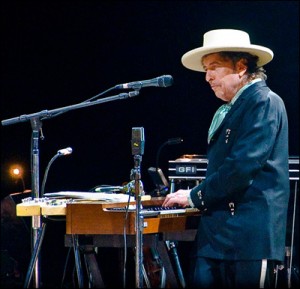
Bob Dylan came to Rochester Institute of Technology for his Never Ending Tour, which has been living up its name since 1988.
In a recent Rolling Stone interview, Barack Obama actually complimented Bob Dylan on the reserved attitude he had during a White House performance. After playing “The Times They Are A-Changin’,” Obama said Dylan “comes up, shakes my hand, sort of tips his head … then he left. And I thought: That’s how you want Bob Dylan, right? You don’t want him to be all cheesin’ and grinnin’ with you.”
The crowd at Dylan’s Nov. 6 concert in RIT’s Gordon Field House must be honored then, as they also received the presidential treatment. Throughout the concert, which ran a little over two hours, Dylan never offered any greetings, never spoke any stage banter in between songs, and almost never betrayed his cold, concentrated stare.
He’s one of the few performers who rightfully knows his mere aura is enough to captivate — hell, one of the most exciting points of the whole performance were the few seconds right before it started, when all the audience could see was an imposing figure in a white, wide-brimmed hat standing in the darkness. I’ve never been one to make Dylan out to be superhuman, but damn, in those few seconds I’m sure everyone knew they were really in the presence of greatness.
Dylan and his five piece band immediately launched into “Rainy Day Women #12 and 35,” the infamously wacked-out opener of “Blonde on Blonde.” Only the song didn’t really sound that wacked-out — its bizarro brass instruments were eschewed in favor of lean, thunderous rock.
In fact, Dylan’s backing band contributed as much to the concert’s glory as the man himself, if not more — guitarist Charlie Sexton and crackling drummer George Recile were marvels by themselves.
The band toyed around with the old arrangements of “Just Like Tom Thumb’s Blues” and “Simple Twist of Fate,” stretched “Honest With Me” and “Highway 61 Revisited” into play-off-each-other jams, and provided every song with the loud and rough blues this material deserves.
Dylan, on the other hand, was a more complex presence, as was expected. Now that the shock of his voice’s transformation into grainy scowl has disappeared, the real shock was hearing how strangely that voice translated in a live performance.
At this concert, Dylan’s voice was in rougher shape than even his latest records indicate — it cracked and collapsed several times, and his words were often incomprehensible.
At most concerts, each song is greeted with cheers of recognition by the audience. At this one, you had to sometimes wait a minute before making out a series of two or three discernible words that helped you know what song was even being played.
His vocalizing had varying effects — it certainly took away from the subtle tenderness of “Simple Twist of Fate” and obscured the apocalyptic narrative of “Ain’t Talkin’.” Meanwhile, his embittered groan was a perfect fit for the fed-up anthem “Things Have Changed,” and also added even more dark menace to “Ballad of a Thin Man,” proving that time has done nothing to deplete that song’s strong social anger.
Either way, the most important aspect of this concert is simply that it was Bob Dylan, on stage, performing with every bit of vitality fans would expect.
At any Dylan concert, there’s very few expected songs — his set lists are a mix of a few mainstay songs, and anything else from his catalogue is up for grabs. This set list was surprisingly centered more around recent material and lesser-known surprises than the obvious classics.
Almost half of the songs came from 2001’s “‘Love and Theft,” 2006’s “Modern Times” and last year’s “Together Through Life” (he thankfully left out anything from “Christmas in the Heart,” that other Bob Dylan album from last year). He also exhumed obscurities like “Señor (from Tales of Yankee Power),” from 1978’s much maligned album “Street Legal,” and “Cold Iron Bounds,” the underappreciated epic at the center of “Time Out of Mind.”
Dylan switched between guitar, organ and what’s still the meanest sounding harmonica in rock and roll, delivering an unbroken stream of great performances while always maintaining his collected composure.
After concluding with “Ballad of a Thin Man,” Dylan and his band came back for the encore, performing the “Together Through Life” song “Jolene.” And then, Dylan finally did what I wasn’t expecting him to do: He smiled, dropping the impenetrable façade for just a moment, and said, “Thanks for joining us.” He introduced every single one of his band members, and then launched into his signature finale, “Like a Rolling Stone.”
Dylan couldn’t hold the notes for the song’s iconic chorus, but it didn’t matter at all here. The audience — in terms of age, probably the most diverse I’ve ever seen — sang along and celebrated the song with enough energy to make it a complete, joyous performance.
And then, after delivering the most ecstatic moment of the night, Dylan calmly lined up with his band members and gave a slight bow. Then, just like that, he was gone. That’s the way you want Bob Dylan, right?
Silverstein is a member of the class of 2013.
